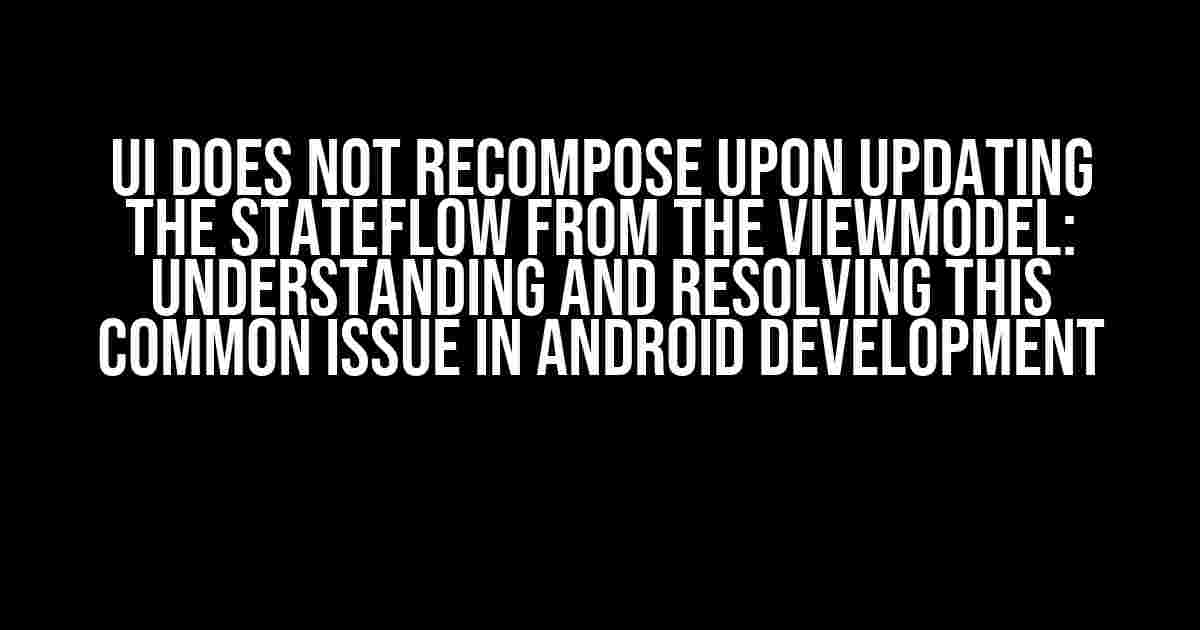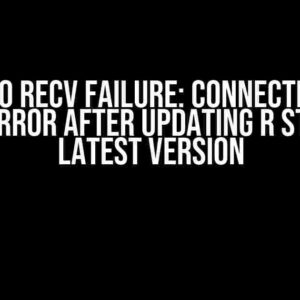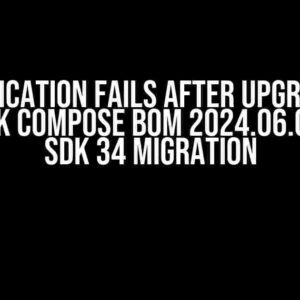As an Android developer, you’ve likely encountered the frustrating issue where your UI doesn’t recompose after updating the state flow from your ViewModel. This problem can be puzzling, especially if you’re new to Android development or unfamiliar with the intricacies of state flows and ViewModels. Fear not, dear developer! In this comprehensive guide, we’ll delve into the root causes of this issue, explore the consequences of not addressing it, and provide step-by-step solutions to get your UI recomposing smoothly.
What is State Flow and ViewModel in Android Development?
Before we dive into the issue at hand, let’s quickly review what State Flow and ViewModel are in Android development:
State Flow: A State Flow is a Kotlin API that allows you to handle asynchronous data streams in your Android app. It’s part of the AndroidX libraries and provides a way to emit values from a suspend function, making it ideal for handling background tasks, API calls, or other asynchronous operations.
ViewModel: A ViewModel is an architectural component that acts as an intermediary between your app’s UI and business logic. It’s responsible for exposing data and functionality to the UI, while also handling data storage and retrieval, networking, and other tasks. ViewModels are typically used in conjunction with State Flows to manage and update the UI.
The Problem: UI Doesn’t Recompose Upon Updating the State Flow from the ViewModel
When you update the state flow from your ViewModel, you expect the UI to recompose and reflect the changes. However, sometimes the UI doesn’t update, leaving you wondering what’s gone wrong. This issue can manifest in various ways, such as:
- Data not updating in the UI despite changes in the ViewModel
- UI not refreshing after updating the state flow
- State flow updates not triggering UI recomposition
This problem can be attributed to several factors, which we’ll explore in the next section.
Causes of the Issue:
The following reasons might contribute to the UI not recomposing upon updating the state flow from the ViewModel:
- Incorrect State Flow setup: Improper configuration of the State Flow, such as not using the correct scope or context, can prevent the UI from recomposing.
- ViewModel not properly configured: Failure to set up the ViewModel correctly, including not using the correct lifecycle or scope, can lead to UI recomposition issues.
- Incorrect usage of LiveData or MutableLiveData: Misusing LiveData or MutableLiveData can cause the UI to not recompose, especially when working with State Flows.
- Lack of Observers or Subscribers: Not setting up observers or subscribers correctly can prevent the UI from receiving updates from the State Flow.
- Scope and Context Issues: Incorrect scope or context usage can cause the State Flow to not emit values to the UI.
- Multi-Threading Issues: Failure to handle multi-threading correctly can lead to UI recomposition issues when working with State Flows.
Step-by-Step Solution to UI Not Recomposing Upon Updating the State Flow from the ViewModel
Now that we’ve explored the causes, let’s dive into the solutions! Follow these steps to ensure your UI recomposes correctly when updating the state flow from your ViewModel:
Step 1: Verify State Flow Setup
import kotlinx.coroutines.flow.*
// Create a State Flow in your ViewModel
private val _myStateFlow = MutableStateFlow<String>("Initial Value")
val myStateFlow: StateFlow<String> = _myStateFlow
Step 2: Configure ViewModel Correctly
import androidx.lifecycle.ViewModel
import androidx.lifecycle.ViewModelProvider
// Create a ViewModel with the correct scope and context
class MyViewModel(private val application: Application) : ViewModel() {
// ...
}
Step 3: Use LiveData or MutableLiveData Correctly
import androidx.lifecycle.LiveData
import androidx.lifecycle.MutableLiveData
// Use LiveData or MutableLiveData to observe the State Flow
private val _myLiveData = MutableLiveData<String>()
val myLiveData: LiveData<String> = _myLiveData
Step 4: Set Up Observers or Subscribers
import androidx.lifecycle.observe
// Set up an observer in your Fragment or Activity
myViewModel.myLiveData.observe(this, Observer { value ->
// Update the UI with the new value
textView.text = value
})
Step 5: Handle Scope and Context Correctly
import androidx.lifecycle.ViewModelProvider
import androidx.lifecycle.ViewModelStoreOwner
// Ensure the correct scope and context when creating the ViewModel
myViewModel = ViewModelProvider(this, MyViewModelFactory(application)).get(MyViewModel::class.java)
Step 6: Handle Multi-Threading Correctly
import kotlinx.coroutines.Dispatchers
import kotlinx.coroutines.withContext
// Use withContext to switch between threads when updating the State Flow
withContext(Dispatchers.Main) {
_myStateFlow.value = "New Value"
}
By following these steps, you should be able to resolve the issue of the UI not recomposing upon updating the state flow from the ViewModel.
Additional Tips and Best Practices
To avoid similar issues in the future, keep the following tips and best practices in mind:
- Use a consistent naming convention for your State Flows and LiveData.
- Ensure correct scope and context usage when creating and updating State Flows and ViewModels.
- Use the correct type of LiveData or MutableLiveData based on your requirements.
- Avoid using multiple instances of the same State Flow or LiveData.
- Use Android Studio’s built-in debugging tools to identify and fix issues.
Conclusion
In conclusion, the UI not recomposing upon updating the state flow from the ViewModel is a common issue in Android development that can be resolved by following the steps outlined in this article. By understanding the causes of the problem and implementing the correct solutions, you can ensure seamless UI recomposition and provide a better user experience for your app’s users.
| Keyword | Definition |
|---|---|
| State Flow | A Kotlin API for handling asynchronous data streams in Android apps. |
| ViewModel | An architectural component that acts as an intermediary between the UI and business logic. |
| Lifecycle | The sequence of states an Android app goes through, from creation to destruction. |
| Scope | The lifetime of an object or component in an Android app. |
| Context | The environment in which an Android app runs, providing access to system resources. |
Remember, a well-structured and well-maintained codebase is key to avoiding issues like this in the future. Happy coding!
Frequently Asked Question
Stuck with UI not recomposing when updating the state flow from the ViewModel? Worry not, friend! We’ve got you covered with these FAQs.
Why does my UI not recompose when I update the state flow from the ViewModel?
This might be because your state flow is not being collected by the UI. Make sure you’re using the ` collectAsState()` function to collect the state flow in your composable function. This function will convert the state flow into a `State` object that can be observed by the composable function.
I’m using `collectAsState()` but my UI still doesn’t recompose. What’s going on?
Double-check that you’re not accidentally using a ` launch` block to update the state flow. `launch` blocks are not suspending functions, so they won’t block the UI thread. Instead, use `viewModelScope.launch` or `scope.launch` to update the state flow. This will ensure that the UI thread is blocked until the state flow is updated.
I’m using `viewModelScope.launch` but my UI still doesn’t recompose. What’s the issue?
This might be because you’re not using the `Dispatchers.Main` context when updating the state flow. Make sure you’re using `withContext(Dispatchers.Main)` to update the state flow on the main thread. This will ensure that the UI thread is updated correctly.
I’ve checked everything and my UI still doesn’t recompose. What should I do?
Take a deep breath and debug your code! Use the Android Studio debugger to step through your code and see where the issue is occurring. You can also use logging to see what’s happening when you update the state flow. This should give you a better idea of what’s going on and where the issue lies.
Is there a way to force the UI to recompose when updating the state flow?
Yes, you can use the `LaunchedEffect` API to force the UI to recompose when updating the state flow. Simply wrap your UI composable function with `LaunchedEffect` and pass the state flow as a key. When the state flow changes, the `LaunchedEffect` will re-run and the UI will recompose.




